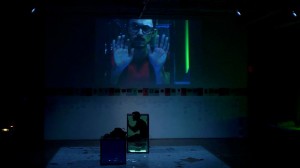
I came of age as a playwright witnessing 9/11 and its aftermath—the War on Terror and a grass-roots revolt manifest in the streets, and in the theater, speaking up against war. A few days after the terrorist attacks, I remember sitting at an auditorium at NYU and one of my classmates asking: “what is the point of writing in times of war?” This question lingered in my mind and for ten years, I studied both playwriting and peace studies, while I traveled around the world in search of contemporary, theatricals models that could help me integrate my passions for playwriting and peace.
The World Premiere of TALA was a turning point in this search, a moment in which theory and practice was brought together through the telling of my post 9/11, immigrant story in the context of my childhood in Chile, which was shaped by Pinochet’s dictatorial regime which began with a military coup on September 11th, 1973—or what Chomsky calls “the first 9/11.”
TALA merged all the different identities I claim as an artist—Korean, Chilean, American, immigrant, gay—and tackled the broken systems through which I had to jump hurdles to create my work. Parallel to this story, I wrote the story of Pepe and Lupe, two Chilean revolutionaries going out on a bad date, the night before Pinochet’s coup. Pepe and Lupe’s dialogue was inspired by the correspondence between Pablo Neruda and Gabriela Mistral, Chile’s two Nobel Laureates, as their personal histories were constantly revised throughout the creative process of TALA.
Neruda, who gave his nomination to the Chilean Presidency to Salvador Allende, died on Sept. 23, 1973 and following decades of suspicions that his death was not of natural causes, his body was exhumed in 2013 to be tested by forensic examiners. Around the same time, Gabriela Mistral’s final years were re-examined, as her lesbian relationship to Doris Dana (a former employee of the US State Department) was revealed through a bounty of long-lost letters, audio recordings, writings, and images gathered in Mistral and Dana’s home in Long Island, New York.
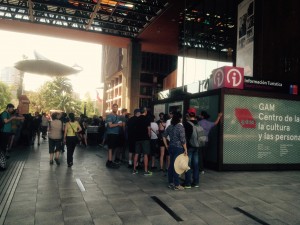
As the metanarratives of Chilean history were being revised, it felt urgent for me to return back to my roots. And after fifteen years living abroad, returning to Chile was a transformational experience, as I often felt like a Chilean artist living in self-exile, like the painters, poets, novelists, and filmmakers that left the country as their political inclinations and art where either censured, or doomed to obscurity during the regime.
During my artistic residency at Centro Cultural Gabriela Mistral (GAM) the history of Chile’s transition to democracy was inescapable. GAM was built in 1972 under Allende’s government and became a hub for Chilean artists, but the building was taken over by Pinochet’s regime as a political center, and eventually as part of the Ministry of Defense, before Michelle Bachelet’s government resumed the space’s interrupted history in 2006 by transforming GAM into a cultural space for the arts, music, and the public. This year, GAM is celebrating the 70th anniversary of Mistral’s Nobel award, which marks the first time a Latin America individual received such distinguished recognition.
My primary objective in Santiago was to re-connect with Chilean theater and its artists, and during an action-packed month, I was able to connect with GAM’s community, the local arts scene, and the international community from Latin America, US, Europe, and Asia that engages with Chilean theaters, its artists, and audiences in Santiago.
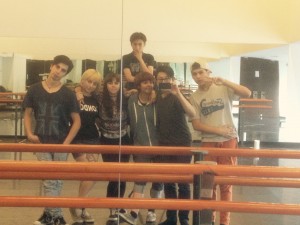
I primarily worked with two popular, dancing troupes that gather around GAM’s public plazas to dance K-Pop (Korean pop) choreographies. My objective was to ask why this phenomenon was taking place, and during my process of research I discovered that three years ago, Daniel Zamudio, a young, K-Pop dancing teenager was murdered by Chilean Neo-Nazis at Parque San Borjas, a park two blocks away from GAM.
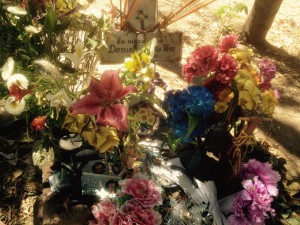
The death of Zamudio led to protests, vigils, and a new piece of anti-discriminatory legislation called the “Zamudio law,” criminalizing homophobic hate crimes in Chile. Parque San Borjas is still one of the main gathering places for these dancers, and considering the need of this community for a safe space, GAM invited them to rehearse in their plazas, as security would be provided.
These young troupes often come from marginalized and under-resourced communities in the periphery of Santiago, where access to the arts is limited, so the glass walls surrounding GAM provide a much needed mirror for them to practice their choreographies. The purpose of their rehearsals is to perfect K-Pop dance routines, which they learn off YouTube videos, and to perform these dances in local competitions, with the hope of earning the top award in a competition organized by the Korean Embassy—a free trip to South Korea to meet K-Pop stars.
Working with me in this project was a risk for these dancers. After our final presentation, they confided that they didn’t believe anything would come out of this process. This same worry crossed my mind, as I was meeting them all for the first time (following an open invitation to the community to participate), and GAM and I fervently discussed the best platform to present the work we created by the end of my residency.
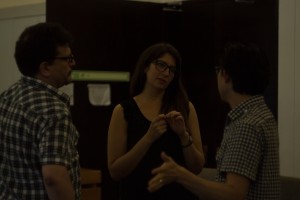
My artistic work in New York fluctuates between the performances I write, direct, and produce through my company, Kyoung’s Pacific Beat, and the work I create with community. In this case, I was challenged to work with teenagers for the first time, and it was my responsibility to keep both artistic and pedagogical objectives in mind. What was there to teach during this collaboration? What were our challenges and how could we overcome them creatively? How could I ensure GAM would provide us a safe space to work, protecting the participants from the homophobia, censorship, and cyber-bullying they experience for dancing forms outside traditional Chilean forms?
The creation of K-ONDA HAMLET began parallel to an “Experimental Playwriting” workshop I taught at Matucana 100 through INTERDRAM, an emerging theater company supporting contemporary Chilean playwrights. With a group of seven writers, we discussed the history of experimental playwriting and the American avant-garde, as a way to expand existing notions of dramaturgical structures in Chile, which are still heavily influenced by modern European plays, an older generation of Chilean playwrights, and a certain vacuum that exists among Chilean writers, who primarily work in isolation or in closed, ensemble-based theater companies, usually established after graduating from college, where most (if not all) are trained primarily in acting.
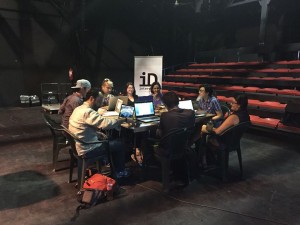
This lack of specialization in playwriting did not deter us in the work. If anything, devising, improvising, and collaborative theater-making are a norm, making experimental playwriting not only a good fit for those pursuing a path in playwriting in Chile, but also a strong methodology to support existing forms of artistic creation.
In the writing of K-ONDA HAMLET, which was created through the same dramaturgical techniques I taught in my workshop, we collaged the story of Daniel Zamudio, with a Spanish adaptation and translation of Heiner Muller’s HAMLETMACHINE, interviews I conducted with the project’s participants, and various K-Pop songs and choreographies. It took us about 2/3 of the process to understand how to stage the multiple levels of narrative weaved together in the script, and the writing, staging, and choreographic work happened all at once in the room. We addressed certain issues—such as the training of their voices—at the same time we were figuring out the characters and the play’s emotional logic. Determining our relationship with the audience was also a constant discussion, as the performers shape-shifted from performing Shakespearean characters, to themselves, and the Korean pop stars they emulated as they danced.
K-ONDA HAMLET became a project we created to represent a community gravely misunderstood. For the past few years, a younger generation of Chilean people have been labeled “tribus urbanas,” or “urban tribes,” that gather based on collective interests stemming from globalized, pop culture icons—Pokemon, Korean pop stars, Michael Jackson—all become ways of relating, supporting a self-identification process for those who do not see themselves represented in mainstream Chilean culture. Furthermore, this collective gathering, celebration, and newfound freedom in Chile are often compared to the cultural explosion that took place in Spain, following the fall of Franco’s regime.
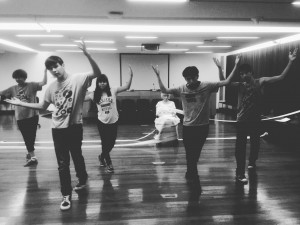
During rehearsals, and in our final presentation, the performers spoke out on how the media liked to portray them as a lost, drug-addicted, gay and/or lesbian youth that sought to escape family problems, and through the project, we expressed how they wished they were recognized as artists instead—artists who self-organize to form groups, claim public spaces to rehearse, and raise funds to produce their costumes, travel to competitions, and pay for their registration fees to perform. As a self-producing artist, I could whole-heartedly related to their struggles and wanted to honor their desires.
Self-production, or “auto gestión,” is the norm in Chile, and during my last week of residency I was invited to join TCG’s delegation to Santiago and be part of Festival Santiago a Mil’s (FITAM) Lab Escénico, one of many workshops organized by FITAM to support the professional development of local artists. In a candid conversation with emerging Chilean producers, moderated by Linda Chapman (New York Theatre Workshop) and featuring Lisa Portes (Latina/o Theatre Commons), Rachel Sullivan (Urban Stages) and I, we talked about our organizations’ business models, the way they could be of used in Chile, and heard the challenges the participants faced in Santiago. A lack of community, role models, and organizational structures stuck out in the discussion, in addition to the lack of understanding and outright rejection of ideas germinating outside existing institutions. The challenges of starting something new without constantly reinventing the wheel sounded familiar, and obviously, the lack of funding and institutional support to build collective skills needed to be addressed more deeply, to empower those present in the room to build community and share resources amongst themselves.
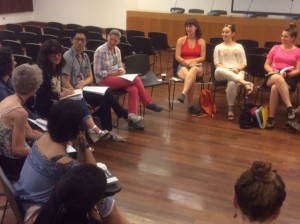
Guillermo Calderón, a pioneering new voice in the international theater scene has exposed the world to stories from the Chilean dictatorship, and the fascination with this history is evident by the wide reach of his work around the world. But past this narrative, which keeps causing social unrest in Chile, there is an overwhelming number of stories being told about the disappointment of leftist radicals whose dreams were interrupted, and a critique to the complacency which people have adopted as Chile’s economy grows to become one of the most stable in the region. Stories of massacre in indigenous communities, the unresolved histories between Chile and Argentina, Perú, and Bolivia (its neighboring countries) abound, and the frustrations with social issues in education, labor, immigration, and income inequality remind Chilean audiences that in terms of social equity, there is far more work to be done.
K-ONDA HAMLET was performed for an invited audience comprised of GAM’s artistic leadership, family, and friends. Following the presentation, the precarious and vulnerable position of these dancers was made visible, and tackling the way the media created discriminatory assumptions about their work, and why they do it, it became clear to us that to make changes, we first needed to change our minds. Herbivoro Films, a two-person team of local filmmakers, captured our work and after collaborating in the work’s editing, we launched a trailer and full recording of our presentation via GAM’s Youtube channel to make it immediately accessible to the community, for free.
K-ONDA HAMLET was released during FITAM’s PLATEA, a week dedicated to international presenters that travel to Chile to view the best contemporary Chilean and international theater. This week ran parallel to the beginning of Santiago Off, a festival where more than 90 new works would take place across the city. In this time of theatrical abundance and exuberance, I felt an overwhelming feeling that my time in Santiago had just scratched the surface and that I’d barely seen what it had to offer.
Thankfully, with support from TCG’s Global Connections program, I was able to form and cement profound professional relationships and I believe that this trip is the beginning of a long-lasting, artistic dialogue between my work with Kyoung’s Pacific Beat in New York City and the theater artists, and arts organizations, nurturing contemporary theater in Santiago.